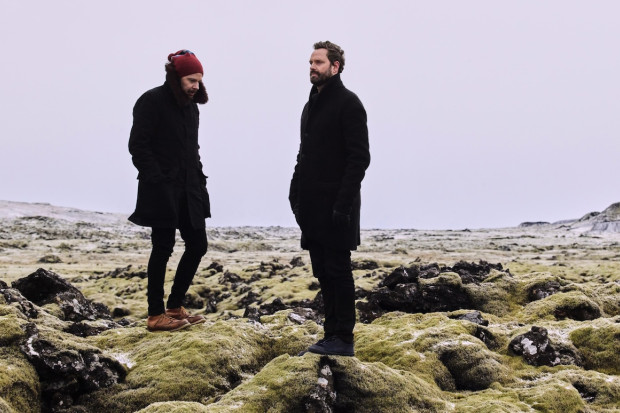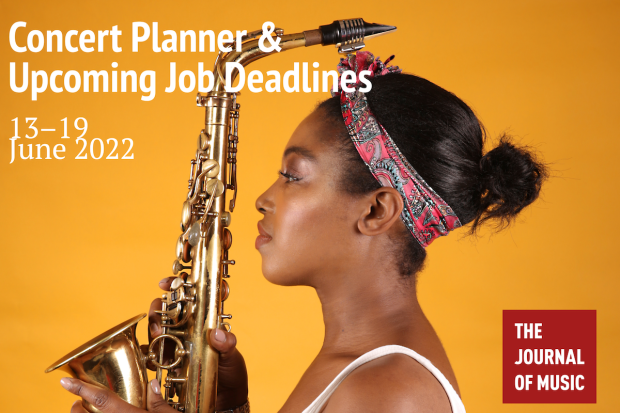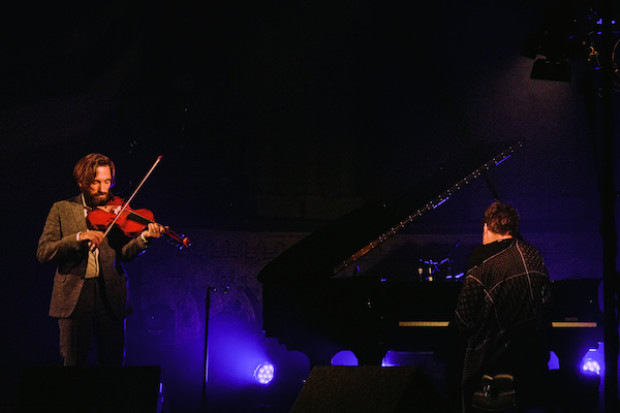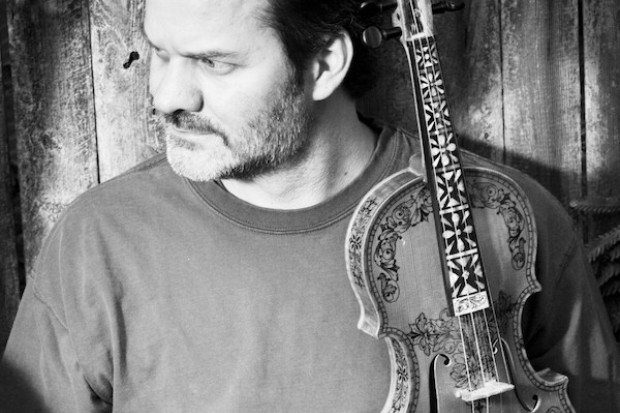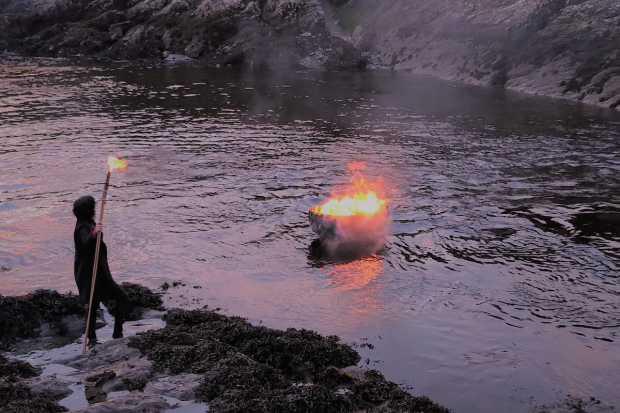
Composer Karen Power with the Invitation to Wander sound choir (in rehearsal)
Lose Myself in this World
This reviewer has fond memories of a previous performance by both Karen Power and the Quiet Music Ensemble that was part of the 2016 Cork Midsummer Festival. Located at Cork City Gaol, which once housed nineteenth-century prisoners, it featured a programme of pieces performed by the group and a new composition, Is This On?, by Power relating to broadcasting history. As the fading evening sunlight streamed through the gable windows, thoughts turned to the long departed former occupants of the space: What did such a sight mean for them? Some of the musical selections achieved a particular potency as they resonated within the historic walls, conjuring up its own cast of ghosts. It confirmed how evocative certain marriages of sound and place can be.
Invitation to Wander at this year’s festival saw both parties return to create a multifaceted performance under the direction of Power. A work that exercises a greater degree of control over the sonic and musical environment and the attendant associations generated by it, the bedrock of the piece is field recordings made by the composer over the years in some of the most remote and inhospitable locations in the world. Augmenting the palette of sounds are the Quiet Music Ensemble (John Godfrey, electric guitar; Roddy O’Keefe, trombone; Dan Bodwell, upright bass; Sean Mac Erlaine, clarinet; and Isle de Ziah, cello), vocalists Ute Wassermann and Michelle O’Rourke, and what Power has described as Ireland’s first amateur sound choir.
Point of departure
Assembling in the adjacent courtyard of Nano Nagle Place, we receive some instructions about what is expected over the next 105 minutes and are divided into three groups before being led into the ground floor of the Cork Centre for Architectural Education. Each group begins their journey at a different place. After being led through a series of dimly lit rooms covered from roof to floor in dark fabric we find ourselves at our point of departure, and it has become apparent that we have begun our excursion at the Amazon. Awaiting us in the narrow room is cellist de Ziah; the muggy sounds of the jungle pipe through the quad speakers. Three monitors are placed around the space and images of flora and fauna of the Amazon appear occasionally on the screens. All the spaces contained projections illustrating each particular space but as we proceeded these seemed less necessary.
Even in this age of affordable travel the Arctic, the Amazon and the great deserts remain remote and alien to us. Our understanding of these environments is confined largely to our television sets through programmes like David Attenborough’s, but even in the case of the great naturalist’s broadcasts the sounds we hear there are mediated by sound recordists, and the sounds used are manipulated to add dramatic colour to particular sequences. So an authentic representation of these environments is largely alien to our ears. By giving us roughly twenty minutes in each environment Power is allowing us time to acclimatise ourselves to the natural rhythms and ambience. Even so, the corrugated steel ceiling visible above us jarred.
Series of clicks
One must acknowledge the difficulty of finding a suitable space to mount something as ambitious as this but we must also be thankful for the arrival of German vocalist, composer and sound artist Ute Wassermann, who perched down at a microphone and proceeded to emit a series of clicks and squawks through her voice, alternating it with a sort of nose whistle which she used to produce a rapid series of high pitched notes. Her intervention, as well as the subtle and spare playing of de Ziah, had a transportive effect.
There was also something wonderfully droll about seeing Mac Erlaine enter the space, take his seat before a microphone, wait for his cue, play a brief series of notes, and pause a moment before leaving, never to return. But that is how nature works.
As some wag once said, it takes a lot of work to be this spontaneous and Invitation to Wander is a complex piece of many moving parts. All the performers wore digital timers on their wrists and some had time-code sequences on wrist cuffs providing further cues. Though unable to discern it in the dark I understand they were also wearing aural speakers in their ears. This guided improvisation has been a feature of Power’s work in recent years.
Nevada and Sahara
We were then ushered into the next space – the desert! Located under a high roof and landing and enclosed by white drapes, the place had an appropriate acoustic spaciousness. We were treated to audio sourced from a number of deserts, which included the Nevada and the Sahara. An image of desert mountains stretching back as far as the eye could see was projected on a wall and O’Keefe’s trombone added a husky tone to the mournful sound of the wind and crumbling sand.
Other environments included the Garig Gunak Barlu National Park in the Australian Outback (a unique wetlands and marine park recorded during the dry season of July 2018, according to the notes) and Svalbard at the High Arctic archipelago.
We completed our navigation of the sonic maze, if not the globe, back in what felt like the Amazon. But this time it was different. The sound of rainfall permeated the space; the atmosphere felt heavy. Like the Arctic recordings, it felt more enveloping and truly immersive. I guess the rain does that. And in the Arctic, we are not just hearing sounds in an expanse of space but hearing the circulatory system of ancient hunks of compacted ice heaving and creaking and pressurised water, a lingua franca of sounds translated by carefully plucked bass and studiously bowed cello. Sound feels tangible.
Rapport
The final room saw de Ziah play high-pitched notes while O’Rourke stretched herself with extended vocal techniques, creating such a rapport as to make one think we were eavesdropping on an imagined conversation between two creatures of different species.
I have not yet mentioned the ten-piece sound choir who entered some of the spaces like a flock of birds, in triangular formation, making shushing and whooshing sounds as they moved through. Curiously I found they did more to suggest a human presence then the vocalisations of Wassermann and O’Rourke and the musicians of the Quiet Music Ensemble. Perhaps that was due to the ostensibly more performative and physicalised nature of their work. Whether that was a desirable thing or not felt entirely subjective. What wasn’t in doubt was the necessity of the durational aspect of the performance.
Some unseen viewer
If Invitation to Wander was a behavioural test and we were the proverbial mice in the maze watched by some unseen viewer then we eventually found our reward, our metaphorical piece of cheese. The earlier stage saw my fellow wanderers occupy the periphery of the rooms, where seats and cushions were placed, but by the final room, two of them felt relaxed enough to stretch out on their backs and knees akimbo. I too felt sufficiently drawn by the pull of the sound to move tentatively towards the centre of the room, all the better to lose myself in this world.
Emerging blinking into the still bright evening and the courtyard with its mixture of tall asymmetrical buildings and pockets of flora, I found a pool of palpable quiet. It felt fitting that this once belonged to a convent, a crucible of contemplation, an oasis in a city which I could hear anew.
For more on Karen Power’s work, visit: http://www.karenpower.ie
Published on 3 July 2019
Don O'Mahony is a freelance arts journalist based in Cork.













